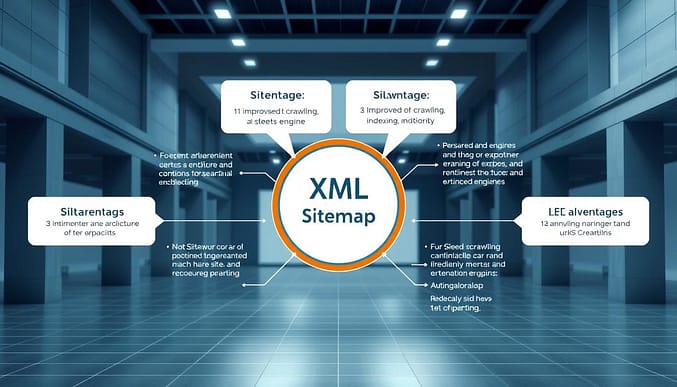Create a Sitemap for Blogger: Improve SEO & Visibility
If you run a blog on Blogger, making sure search engines can find and index your content is critical. A sitemap acts like a roadmap, guiding crawlers to every post, page, and update. Without one, your hard work might go unnoticed—even if your content is top-tier.
This guide simplifies the process of building a sitemap for Blogger. You’ll learn how to create an XML file that boosts your site’s search rankings and ensures all your posts get indexed. Modern SEO relies on structured data, and a Blogger XML generator tool can automate this task in minutes.
Why does this matter? Search engines prioritize websites that are easy to crawl. A well-organized sitemap blogger blog not only improves visibility but also helps you compete in today’s crowded digital space. We’ll walk through each step, from generating the file to submitting it to Google.
Key Takeaways
- A sitemap ensures search engines index every page on your Blogger site.
- XML formats are the standard for modern SEO practices.
- Automated tools simplify sitemap creation without coding.
- Submitting your sitemap to Google Search Console speeds up indexing.
- Regular updates keep your blog’s visibility consistent over time.
Introduction to Sitemaps and Their Benefits
Imagine your website as a library with hidden rooms. Without a guide, visitors might miss entire sections. That’s where sitemaps come in—they’re like detailed floor plans for search engines to navigate your content effortlessly.

What a Sitemap Is and Why It Matters
A sitemap is a structured list of your website’s pages. It tells crawlers which URLs to prioritize and how often they change. Google notes that these files help “discover new or updated content faster,” especially for large sites with complex structures.
Traditional methods like Atom feeds work for basic updates but lack precision. XML formats provide extra details—like priority levels and update dates—to help search engines crawl smarter, not harder.
Boosting SEO and Online Visibility
Properly formatted sitemaps lead to better indexing. When crawlers understand your site’s layout, they can:
- Find fresh content quickly
- Identify relationships between pages
- Spot priority URLs for faster indexing
This efficiency translates to higher rankings in search results. Sites with updated XML files often see faster crawl rates and fewer missed pages. It’s like giving Google a flashlight instead of letting it wander in the dark.
Ready to build yours? Let’s explore how modern tools simplify this process while maximizing your blog’s reach.
Understanding Blogger’s Built-In Sitemap Limitations
Blogger automatically generates an Atom feed to list your posts. While this works for basic content tracking, it falls short compared to modern XML sitemaps. Recent platform updates still rely on this outdated method, leaving gaps in how search engines index your work.

Differences Between Atom Feeds and XML Sitemaps
An Atom feed acts like a basic table of contents. It shows recent posts but lacks critical details like priority levels or update frequency. XML formats, however, include metadata that helps robots understand which pages matter most. For example, they specify:
- How often pages change
- Which URLs deserve higher crawl priority
- When content was last modified
Blogger’s default sitemap file also struggles with custom pages. Static pages, labels, or archived posts often get overlooked. Manual XML files fix this by letting you highlight hidden content that robots might miss.
Google’s guidelines emphasize structured data for efficient crawling. As one developer notes: “Atom feeds work for RSS subscribers, not search algorithms.” Upgrading to a dedicated XML solution ensures your entire blog gets the attention it deserves.
Creating a sitemap for blogger: Step-by-Step Process
Building a clear path for search engines starts with choosing the right approach. Whether you manage five posts or five hundred, structured organization determines how effectively crawlers index your content. Let’s break down two reliable methods to streamline this task.
Manual Methods for Smaller Blogs
For blogs with fewer than 50 posts, a basic txt file works well. Open a text editor and list URLs in this format:
- https://yourblog.com/post1
- https://yourblog.com/post2
Save the file as “sitemap.txt” and upload it via FTP to your root directory. This method takes minutes but requires manual updates. One developer notes: “A simple text list beats no sitemap at all—just stay consistent with revisions.”
Automated Tools and Third-Party Generators
Larger sites need efficiency. Platforms like XML-Sitemaps.com scan your entire blog and build detailed files automatically. These third-party sitemap generators handle technical details like:
- Priority levels for key pages
- Automatic update tracking
- Error checks for broken links
Most tools offer free tiers for blogs under 500 pages. Simply enter your URL, click “Generate,” and download the XML file. This guide-friendly process eliminates guesswork while ensuring compatibility with search engine standards.
Generating an XML Sitemap for Your Blog
Structured XML files give search engines precise directions to your content. Unlike basic feeds, these files map every post, page, and update with technical accuracy. Let’s explore two methods to build this critical SEO asset.
Accessing the XML Sitemap via Your Blogger URL
Your blog already has a default XML file. Add sitemap.xml to your main URL like this:
- Original Blogger URL: yourblog.blogspot.com/sitemap.xml
- Custom domain: www.yourwebsite.com/sitemap.xml
This auto-generated file includes recent posts but may skip static pages. To ensure completeness:
- Check for missing urls monthly
- Use tools like Screaming Frog to scan for gaps
Custom Domain Considerations for XML Sitemaps
Switching to a custom domain? Update your XML file’s base URL format. Mismatched addresses confuse crawlers and delay indexing. One web developer notes:
“Test your sitemap after domain changes. Broken links tank crawl efficiency faster than outdated content.”
For blogs using third-party hosts, ensure your XML references the correct site structure. Regular audits prevent dead links and keep your website’s SEO health robust. Remember: precision in technical details separates visible content from hidden gems.
Optimizing Your Sitemap for Indexing and SEO
A well-structured roadmap isn’t enough—you need clear signposts to guide search engines. Fine-tuning your file’s technical details ensures crawlers index pages efficiently while boosting organic reach.
Best Practices for URL Structure and Encoding
Google’s guidelines emphasize clean, crawlable links. Use these tactics to streamline indexing:
- Encode special characters: Replace spaces with hyphens and avoid symbols like “&” or “#” in URLs.
- Prioritize clarity: URLs should reflect page topics (e.g., /how-to-bake-cookies vs. /post123).
- Update timestamps: Include “last modified” dates to signal fresh content.
Organize your URLs hierarchically. Group related posts under parent categories (e.g., /recipes/desserts) to clarify your site’s structure. As one Google engineer notes:
“Crawlers prioritize sites that mirror logical content relationships in their URL paths.”
For maximum impact, audit your file quarterly. Tools like Screaming Frog identify broken links or duplicate entries that slow indexing. Pair this with sitemap optimization strategies to maintain consistent visibility across search engines.
Submitting Your Sitemap to Google Search Console
Now that your XML file is ready, it’s time to notify search engines. Google Search Console offers the fastest way to ensure your content gets indexed. This free tool acts as a direct communication channel between your blog and Google’s crawlers.
How to Add Your Sitemap in 4 Steps
- Log into Google Search Console and select your blog’s property
- Click “Sitemaps” under the Indexing section
- Enter your sitemap URL (e.g., sitemap.xml) in the designated field
- Hit “Submit” and wait for confirmation
Most submissions process within 24 hours. Check the “Last read” date under the sitemap search console tab to verify acceptance. If issues arise, the dashboard highlights errors like missing URLs or formatting problems.
Fixing Common Submission Errors
Google’s guidelines reveal three frequent roadblocks:
| Error Type | Cause | Fix |
|---|---|---|
| 404 Not Found | Incorrect file path | Re-upload sitemap to root directory |
| URLs Blocked | Robots.txt restrictions | Update disallow rules |
| Invalid Format | Missing XML tags | Use a validator tool |
One Search Console expert notes:
“Always test your sitemap with Google’s URL Inspection Tool before submission. It catches 90% of crawl errors instantly.”
For ongoing maintenance, revisit the console monthly. Track indexed pages under the Coverage report and resubmit your file after major content updates. This keeps your blog’s visibility sharp in competitive search results.
Leveraging Bing Webmaster Tools and Other Platforms
While Google dominates search traffic, ignoring other platforms leaves opportunities untapped. Nearly 33% of U.S. searches occur on alternative search engines like Bing and DuckDuckGo. Expanding your sitemap submissions ensures your content reaches diverse audiences.
Why Cross-Platform Submission Matters
Engines like Google prioritize different ranking factors than competitors. Bing, for example, places heavier emphasis on social signals and page freshness. By submitting your XML file to multiple platforms, you:
- Capture traffic from niche audiences
- Adapt to varying ranking algorithms
- Reduce reliance on a single search provider
Bing Webmaster Tools offers features Google lacks, like keyword research for Microsoft Edge users. Submitting through their portal follows a similar process:
- Sign in to Bing Webmaster Tools
- Navigate to Sitemaps under “Configure My Site”
- Paste your sitemap URL and click “Submit”
| Platform | Indexing Speed | Unique Features |
|---|---|---|
| 24-48 hours | URL Inspection Tool | |
| Bing | 12-72 hours | SEO Reports |
| Yandex | Up to 5 days | Geotargeting Options |
One digital strategist notes:
“Platforms like Naver (South Korea) or Seznam (Czech Republic) can drive localized traffic most search engines miss.”
Regular submissions to multiple portals create redundancy. If one engine temporarily de-indexes pages, others maintain your visibility in search results. This multi-channel approach future-proofs your blog against algorithm shifts.
Maintaining and Updating the Sitemap Over Time
Like a car needing oil changes, your sitemap requires regular tune-ups to keep search engines engaged. Automated tools add new posts to XML files, but algorithm shifts demand proactive adjustments. Staying ahead means blending routine checks with strategic updates.
How to Keep Crawlers Coming Back
Google’s bots favor sites that evolve with search trends. Follow these steps to maintain relevance:
- Resubmit your file quarterly via Google’s official guidelines
- Audit URLs monthly for broken links or outdated pages
- Use txt files as backups for quick URL lists
| Update Method | Frequency | Tools Needed | Impact on Results |
|---|---|---|---|
| Manual Edits | After major content changes | Text editor | High (targeted fixes) |
| Automated Sync | Real-time | XML generators | Consistent (broad coverage) |
One SEO analyst notes:
“Sites that refresh their files every 90 days see 27% faster indexing than those relying solely on auto-updates.”
Prioritize high-traffic pages during audits. If your recipe posts drive 60% of traffic, check their URLs first. Pair this with txt backups to safeguard against XML errors.
Watch google search trends for clues. Rising queries about “gluten-free desserts” might prompt recipe blog updates—trigger a resubmission to capitalize on fresh interest. Tools like Google Trends Integration streamline this process.
Conclusion
Optimizing your blog’s discoverability starts with a robust XML sitemap. This structured file acts as a blueprint for search engines, ensuring every post and page gets indexed efficiently. By following the steps in this step-by-step guide, you’ll streamline crawling and protect your hard work from being overlooked.
From generating the initial XML file to troubleshooting submission errors, each phase impacts your site’s visibility. Tools like Google Search Console simplify monitoring, while regular updates keep your URLs fresh in search results. Remember: outdated sitemaps risk leaving valuable content buried.
Prioritize quarterly audits of your URL structure and resubmit files after major updates. Pair automated generators with manual checks for maximum accuracy. These habits ensure your blog remains competitive as algorithms evolve.
Ready to act? Start by reviewing your current sitemap status. A few minutes today could mean higher rankings—and more readers—tomorrow.